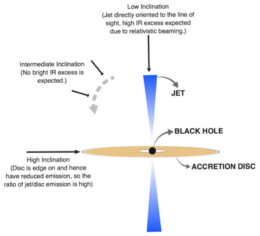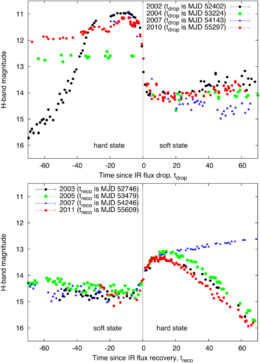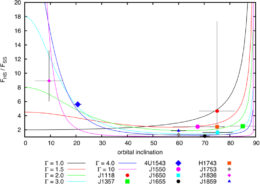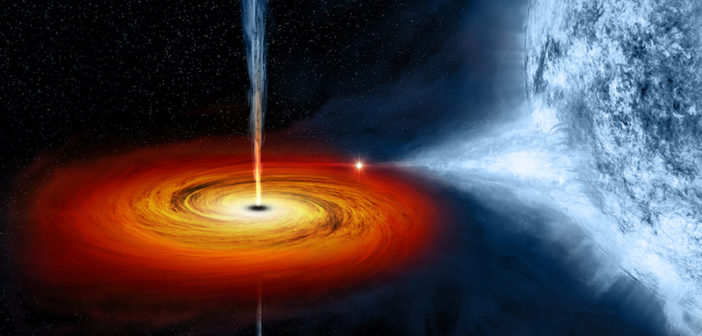An X-ray binary consists of a dense compact object that strips material off its stellar companion, producing X-rays in the process. These binaries are surrounded by radiating accretion disks of infalling material, but they also sometimes fling matter out in powerful relativistic jets. What can their infrared emission tell us about the speed of these jets?
Looking for Lorentz Factors

A schematic of a black hole X-ray binary highlighting the black hole, the accretion disk, and the jets. The expected IR emissions at different inclinations are also explained. Click to enlarge. [Saikia et al. 2019]

Transitions between the “on” (“hard”) to “off” (“soft”) states for the black hole X-ray binary GX 339–4. Multiple light curves are shown to emphasize the repeated transitions between the “on” and “off” states. Top: transition from “on” to “off” (“flux drop”), bottom: transition from “off” to “on” (“flux recovery”). [Saikia et al. 2019]
Eyes on IR Emissions
The IR emission from a BHXB can be largely attributed to two things: the accretion disk and synchrotron emission from the jets. Saikia and collaborators explored the infrared emission from 14 BHXBs, gauging how it changed when the BHXB jets turned “on”, emitting highly energetic X-rays, and “off”, emitting less energetic X-rays. Saika and collaborators argue that when the jets were “off”, any observed IR emission could be attributed to the disk; when they were “on”, the excess IR emission was due to the jets. This framework for looking at the BHXBs allowed the authors to isolate the jet emission and characterize the Lorentz factors for some of these outflows.
Inclined to Model
To determine the Lorentz factors, Saikia and collaborators used the IR flux ratio between the states when the jets were “on” and “off”. Here disk inclination comes into play: due to a combination of disk geometry and relativistic beaming of the jet, at high and low disk inclinations, the ratio between the “on” and “off” states ought to be high. For intermediate inclinations, the ratio should be low.

The modeled flux ratios between the “on” and “off” states versus disk inclination for different Lorentz factors, with observed BHXBs overplotted. [Saikia et al. 2019]
With more observations of BHXBs across the spectrum, the techniques in this work should be more widely applicable and could help us better understand these highly energetic objects.
Citation
“Lorentz Factors of Compact Jets in Black Hole X-Ray Binaries,” Payaswini Saikia et al 2019 ApJ 887 21. https://doi.org/10.3847/1538-4357/ab4a09

1 Comment
Pingback: From AAS NOVA: ” Jet-Setting in the Infrared” | sciencesprings